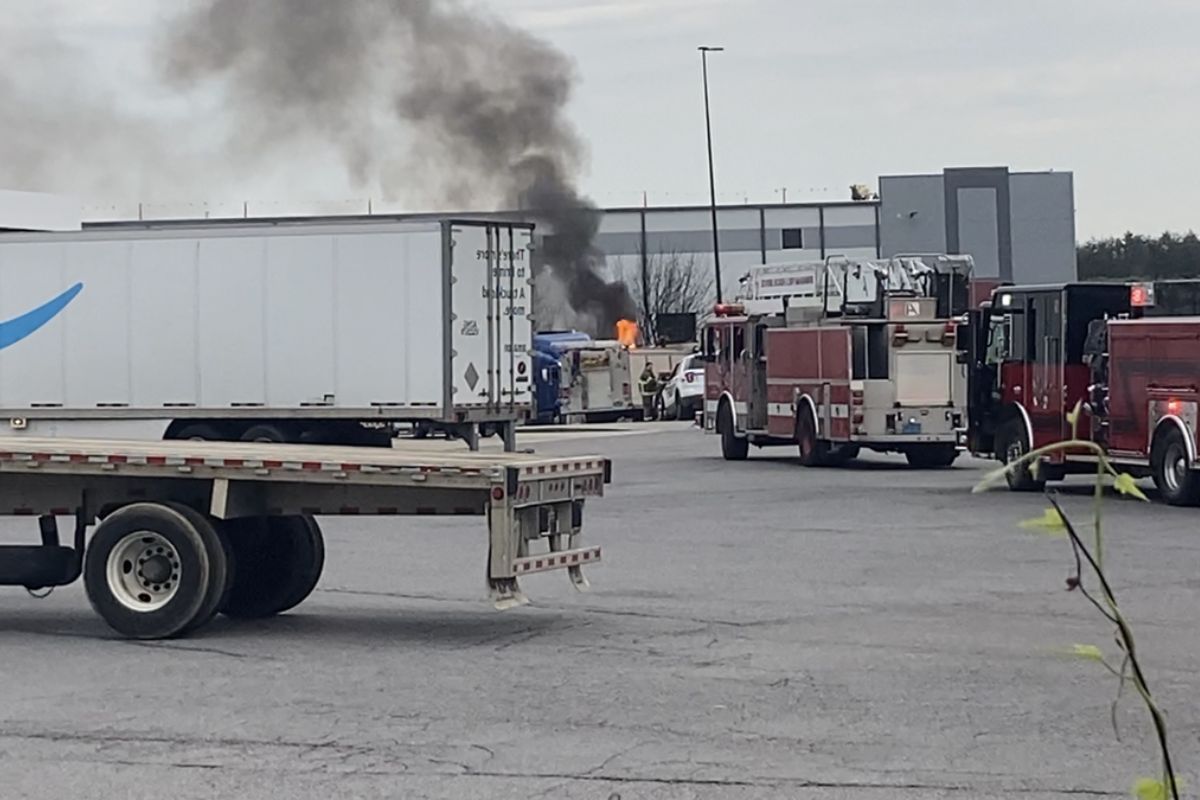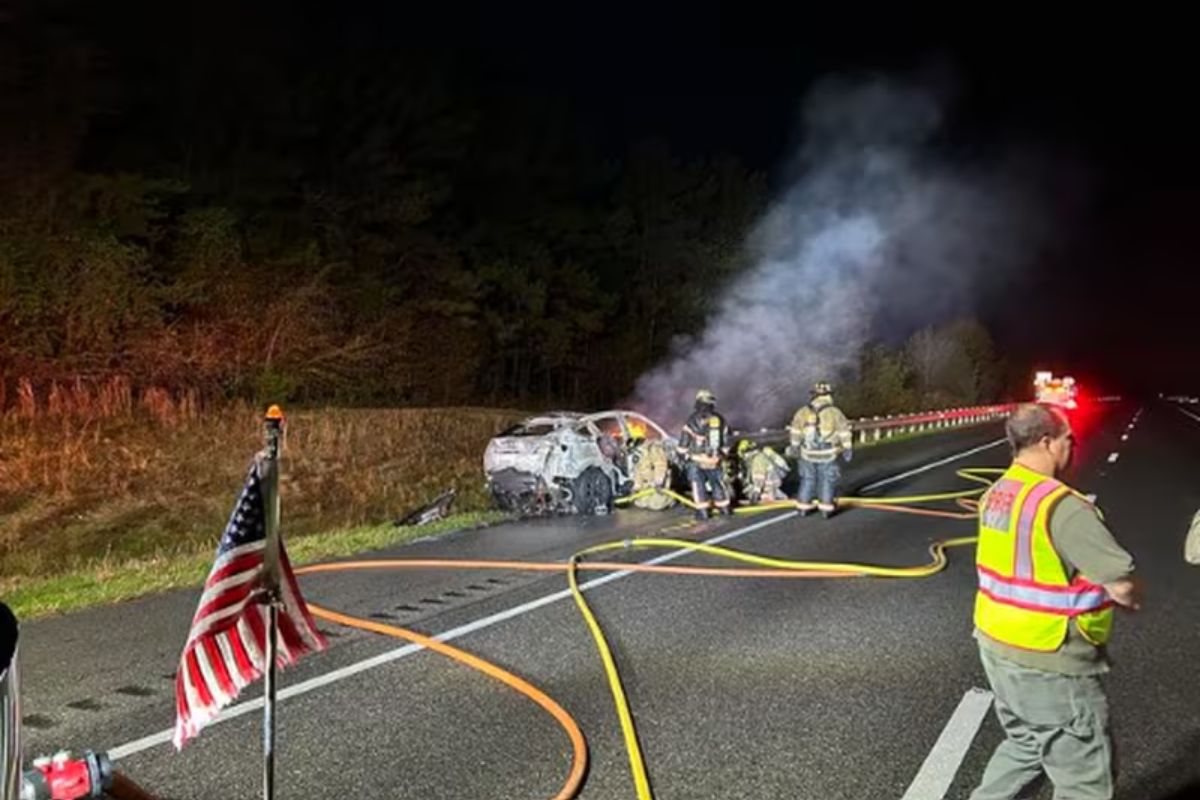Alabama Firefighters Navigate Hazards: Electric vehicles (EVs) are becoming increasingly popular, but with their rise comes a new set of challenges for firefighters.
In Alabama, firefighters are navigating the hazards of electric vehicle fires, which present unique difficulties due to the nature of their lithium-ion batteries.
This article explores the risks and toxicity associated with EV fires, as well as the importance of public perception and safety education.
It also provides safety recommendations for firefighters to effectively handle these emergencies.
Key Takeaways
- High-voltage electrical systems in electric vehicles pose risks to occupants and first responders, necessitating specialized training to handle the potential for electrocution.
- Lithium-ion batteries used in EVs present firefighting difficulties, such as limited access for firefighters and the higher risk of thermal runaway, requiring specialized training and equipment.
- Extinguishing EV fires with water can emit toxic smoke and gases, necessitating a controlled burning approach and the need for safety measures to protect responders and the public.
- Public perception and safety education are crucial, with a need to manage public expectations, educate about specialized training and equipment, and inform about precautions to prevent EV fires.
Unique Challenges of Electric Vehicle Fires
Navigating the unique challenges of electric vehicle fires requires a specialized understanding of the hazards involved. Unlike traditional combustion engine fires, EV fires present additional complexities that firefighters must be prepared to handle.
One of the primary challenges is the presence of high-voltage electrical systems within the vehicle, which can pose a significant risk to both the occupants and the first responders. Firefighters need to be aware of the potential for electrocution and take appropriate precautions to ensure their safety.
Additionally, the batteries in EVs contain large amounts of energy, which can lead to prolonged burning and reignition if not properly extinguished. Firefighters must be equipped with the knowledge and tools to effectively manage and extinguish these fires, including specialized training and access to resources like thermal imaging cameras to identify hotspots.
Lithium-Ion Batteries and Firefighting Difficulties
One of the key difficulties firefighters face in handling electric vehicle fires is the challenges posed by lithium-ion batteries. These batteries are tightly encased and integrated into the car’s structure, making it difficult for responders to access them.
Here are three specific difficulties that firefighters encounter when dealing with lithium-ion batteries in EV fires:
- Limited effectiveness of water: The tightly encased nature of lithium-ion batteries prevents water from effectively reaching them. Water is typically used to extinguish fires, but in this case, it may not be sufficient to cool down or extinguish the battery fire.
- Potential for thermal runaway: Lithium-ion batteries have a higher risk of thermal runaway, which means that once ignited, the fire can rapidly spread and become more intense. This poses additional dangers and challenges for firefighters trying to control the fire.
- Extended burning duration: Lithium-ion battery fires can burn for an extended period, making it challenging for firefighters to fully extinguish the fire. This prolonged burning duration requires a more strategic and careful approach to ensure the fire is completely under control.
These difficulties highlight the need for specialized training and equipment to effectively handle electric vehicle fires involving lithium-ion batteries.

ALSO READ: Burning Tesla Requires 36000 Gallons of Water: A New Challenge for Firefighters
Risks and Toxicity in EV Fires
When dealing with electric vehicle fires, firefighters must be aware of the risks and toxicity involved. Extinguishing these fires with water can pose significant dangers due to the toxic smoke and gases emitted, such as hydrogen fluoride.
As the understanding of EV fires evolves, experts recommend a controlled burning approach, emphasizing the hazards of traditional firefighting methods. This means allowing the fire to burn under controlled conditions, rather than attempting to extinguish it with water.
Industry leaders acknowledge the challenges faced in handling EV fires and the potential risks associated with using water. By understanding the risks and toxicity involved, firefighters can better navigate the hazards and ensure the safety of themselves and others when responding to electric vehicle fires.
Public Perception and Safety Education
Public perception and safety education are crucial aspects to address when it comes to managing the complexities and hazards of electric vehicle fires. With the increasing popularity of electric vehicles and other battery-powered modes of transportation, it is important for the public to have a clear understanding of the risks involved and the safety measures in place to mitigate those risks.
One of the main challenges is managing public expectations. Many people assume that firefighters should be able to extinguish electric vehicle fires just like any other fire. However, the unique hazards associated with these fires, such as the risk of thermal runaway in lithium-ion batteries, require specialized training and equipment. It is important to educate the public about these challenges and emphasize that firefighters are working diligently to develop effective strategies for dealing with electric vehicle fires.
Another key aspect of safety education is informing the public about the precautions they can take to prevent electric vehicle fires. This includes proper charging practices, regular maintenance of the vehicle’s battery system, and being aware of potential signs of battery malfunction. By providing this information, individuals can make informed decisions and reduce the risk of fire incidents.
In addition to public education, it is also important to provide ongoing training and support to firefighters and other first responders. This includes equipping them with the necessary knowledge and tools to safely handle electric vehicle fires. Regular training sessions, access to specialized equipment, and collaboration with industry experts can all contribute to ensuring the safety of both the public and the responders.
- Product Specs:
- Battery type: Lithium-ion
- Battery capacity: Varies depending on the vehicle model
- Charging time: Varies depending on the charging station and vehicle
- Pros:
- Environmentally friendly
- Lower operating costs compared to traditional vehicles
- Potential for reduced dependence on fossil fuels
- Cons:
- Limited charging infrastructure
- Higher upfront cost
- Concerns about battery lifespan and disposal
EVs: Growing Concerns and Safety Recommendations
Continuing from the previous discussion, an increasing number of concerns surrounding electric vehicles (EVs) have prompted the development of safety recommendations and measures.
These concerns include:
- Battery Safety:
- Ensuring proper battery management systems.
- Implementing effective cooling systems to prevent overheating.
- Conducting regular inspections and maintenance of battery packs.
- Emergency Response:
- Providing specialized training for firefighters and first responders to handle EV-related incidents.
- Equipping emergency personnel with appropriate tools and protective gear.
- Establishing clear protocols for handling EV fires and accidents.
- Public Awareness:
- Educating consumers about safe battery usage, charging practices, and maintenance.
- Encouraging responsible disposal and recycling of EV batteries.
- Increasing awareness of the potential hazards associated with EVs to promote safer usage.
Electric vehicle fires present unique challenges for firefighters due to the hazards associated with lithium-ion batteries and the risks of toxicity.
It is crucial for public safety education to address these concerns and provide firefighters with the necessary knowledge and tools to effectively navigate EV fires.
As the popularity of electric vehicles continues to grow, it is essential to prioritize safety recommendations and ensure that firefighters are well-equipped to handle these incidents.
Our Reader’s Queries
Does Alabama Fire College offer workplace safety?
Our courses equip your team to confidently handle and recover from hazardous materials incidents caused by transportation and industrial accidents, natural disasters, and illegal drug labs in a safe manner.
How long is fire academy in Alabama?
Complete at least 360 hours of training for Fire Fighter I/II or 200 hours for Fire Fighter Bridge.
Who governs volunteer fire departments in Alabama?
Code 360-X-1-.01 (2015) covers the regulation of volunteer fire departments by the Alabama Forestry Commission. The commission ensures that these departments retain their certification by mandating participation in training programs and other related activities. This requirement is outlined in § 9-3-17 of the Code of Alabama 1975.
Is Alabama Fire College accredited?
In 1982, the Alabama Fire College and Personnel Standards Commission gained accreditation from Pro Board, making it the longest-standing member in the Pro Board system.

